|
|
Post by onlyMark on Mar 14, 2017 15:14:05 GMT
Interestingly this thread by Bixa is also relevant to my latest getting away - anyportinastorm.proboards.com/thread/7949/germany-considers-reparations-namibiaPlus, this one by Tod. Especially the part about the North Korean monument. But for that you'll have to wait a while - anyportinastorm.proboards.com/thread/7690/windhoek-namibia-expansionAlso, there are other excellent threads by nycgirl and Kimby. This is my take for now on the part of Namibia I had time to visit this time. I will be back, probably by myself and flesh it out even more. I hope to do it justice in comparison to those amazing reports from those who have gone before. There will inevitably be a certain amount of repetition of what others have done and there is no way I can improve on their photos with my Indian bought camera. But here goes............... |
|
|
|
Post by onlyMark on Mar 14, 2017 15:40:13 GMT
It started off badly but soon got better. We booked a flight to go to Namibia for a week with Air Namibia. We can drive from here but that would take up two or three days to get to the capital, Windhoek even before we start travelling round. So a flight was the best option. The day before we were due to go I tried to check the booking on the airline's website but it wouldn't let me do so and kept coming up with an error message. I tried to check arrivals and departures from the airports but there was no trace of our flight, only a later one. I couldn't get through to their helpline so a visit to their office was the only option. I sat with a customer service person who checked my booking and after some faffing around on the computer found the times had changed by several hours to the later flight. I asked why I had not been notified of the change, the answer being it had only just happened, that morning, that hour. Yeah, sure. So we turn up at the airport at the new time to be told there had been another change. Yes, it was still going to Windhoek – but via the capital of Zimbabwe, Harare. A direct two hour maximum flight had now changed to an hour to Harare, over an hour sitting on the tarmac and then two and a half hours to Windhoek. Even worse, we had arrived two hours before the flight but told we had to board straight away as it was leaving in 30 minutes, 1 ½ hours early than the new time. It was a reasonably normal flight though – 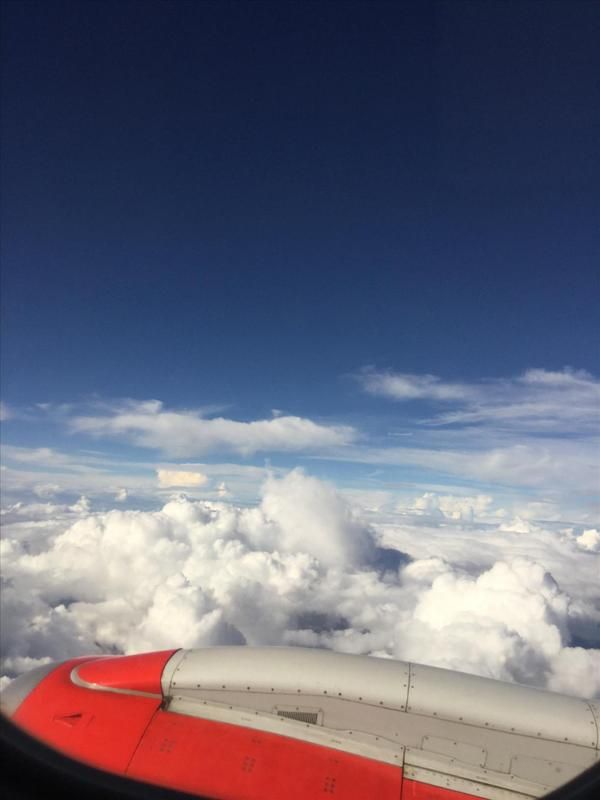 |
|
|
|
Post by onlyMark on Mar 14, 2017 15:41:40 GMT
One good thing though is that I told Air Namibia to contact the car rental firm to tell them of the new arrival time and as it was outside of their office hours Air Namibia would have to pay the extra out-of-hours charge. They agreed and as yet I understand this has been arranged. I've not paid. We left Lusaka in the rain and arrived in Windhoek in the dark and rain. It was looking a bit grim as a start. But, the car rental agency man was waiting. I had booked for us a basic single cab 4wd pick up, the cheapest 4wd you can get. But we were given a Toyota Fortuner, a quite posh SUV. The man said we could still have a pick-up if we wanted but this was better, for the same price. I agreed. Things were looking up. I had booked through my favourite car booking website, economycarrentals.com, have done so many times and never had a problem. You don't know though which actual company you will get until the booking is done, but the one time I didn't like it, they changed without a problem. This time is was with Thrifty. Renting a 4wd in Namibia can cost a lot, up to about Euro 140 a day. This cost us Euro 55 day. A bargain. One reason was this time I didn't need all the camping stuff. We stayed the first night about half an hour away from the airport towards the capital at the Trans Kalahari Inn. As we were quite late the room key had been given to the night guard and we were told to just check in properly the next morning. This went smoothly and we were on our way in good weather. After a quick stop at a supermarket to stock up on water and some travelling junk food goodies, we set off for Swakopmund. When in Namibia by myself I tend to do things a bit more 'hard core' as regards where I go and the tracks I go on, but with having Mrs M with me who had been working very hard, I thought we'd have it all a bit easier. But, that didn't mean we took the main tarmac road to our destination. Nope, I still took the more out of the way gravel track – this meant that for a little under 300km we saw just two other cars. On the way we passed a landmark, being the Liebig House. On 18th September 1907, The Liebig's Extract of Meat Company purchased 210,000ha of land in the Khomas Hochland. A house was built in 1911 and named after Baron Justus von Liebig, the German 19th-century organic chemist who founded the Karl Liebig Company. Farm managers of the company, who were renown cattle breeding specialists, were housed there. Lemco were the originator of Liebig and Oxo meat extracts, which later became known as Oxo beef stock cubes. After changing hands a couple of times, once to the South African government and then to a private buyer, photojournalist Margaret Courtney-Clarke, the house fell into dilapidation – 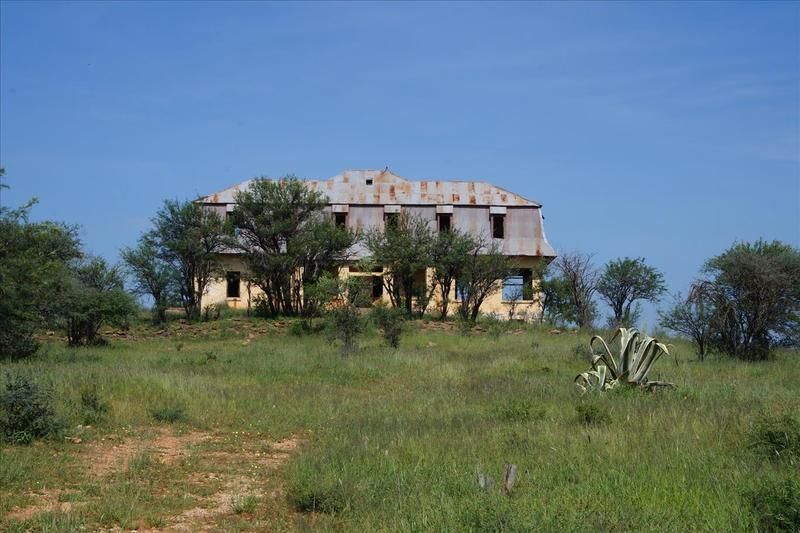 |
|
|
|
Post by onlyMark on Mar 14, 2017 15:42:12 GMT
|
|
|
|
Post by onlyMark on Mar 14, 2017 15:42:44 GMT
One surprise as we dropped down from the heights of Windhoek (elevation 1700m) via a couple of small passes to close to sea level was a sighting of a bit of game. There must have been a game farm nearby. We hadn't come to the country to search for any but it was still a pleasure – 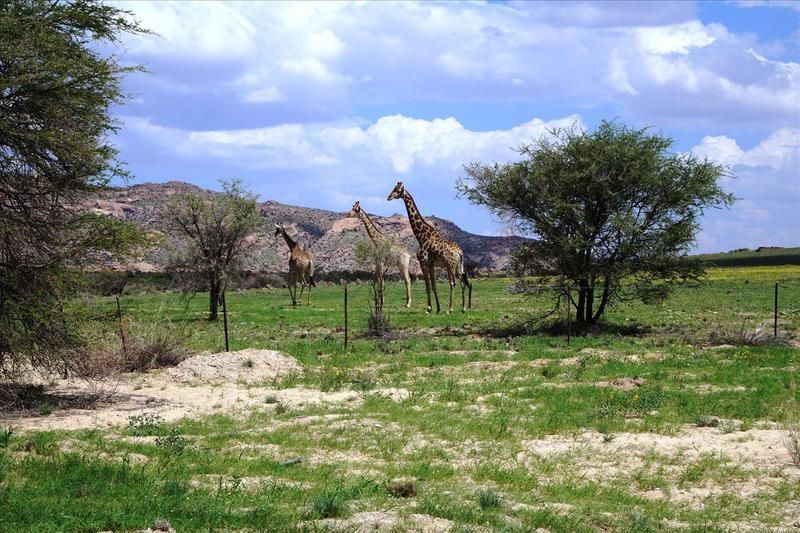  The road became less and less green and I we didn't take any more photos as I knew we'd be seeing a lot of dry dusty places later. After a gentle uneventful drive, just to get us in the mood, and with a short stop for some bread and ham from the earlier supermarket, we entered Swakopmund. First stop, because we were on holiday, was at a place I know called the Village Cafe. I had been hankering for a decent cup of coffee and a piece of their lemon meringue pie. They were near to closing for the day but I managed to snag the last portion – 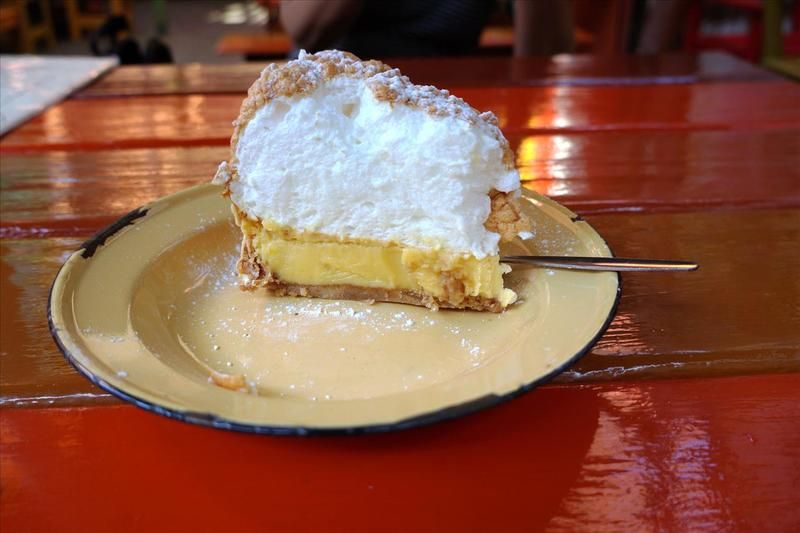 That afternoon and the next day we walked all round the town exploring. There was a quite good museum (no photos allowed unless paid for. So we took some anyway) and took many of the buildings. All I can say is that it is a bit of a weird place, and so much better for it. The times I would normally go there I would spend most of my time quad biking and sand boarding out in the nearby dunes. There are many adventure type activities based there, a recent addition I saw which I definitely won't be doing is camel riding. Been there, done that, got spat at, thankyouverymuch. Hence it was good to just have a mooch round and a looksee. |
|
|
|
Post by onlyMark on Mar 14, 2017 15:43:10 GMT
Swakopmund (meaning the mouth of the Swakop river) has around 45,000 living there (note: Namibia is about 2 ½ times bigger than Germany (population 82 million) and has a population of just around 2.2 million. There is a lot of empty space is an understatement). The town was founded in 1892 as the main harbour for German South West Africa as not far south (about 30km) the British had already grabbed the only proper deep water harbour in the area, Walvis Bay. German colonial troops and some settlers landed first and the town quickly became the centre of import and exports of the whole territory. The problem always was it not being a proper harbour. A concrete and stone wall was built (a 'mole') to try and form one but the protected area soon silted up. In 1905 wooden jetty was built but this soon proved inadequate and so in 1914 a steel jetty was constructed. Unfortunately the next year, 1915, the Union of South Africa defeated the German Forces and took over. As at the time this was connected to the British Empire, which had Walvis Bay anyway, so there became little need to maintain and continue with the jetty which fell into disrepair but was renovated around 2006. Swakopmund also was one of the centres of the German persecution of the local Herero (The Herero Wars) and in town was a concentration camp where several thousand eventually died of thirst and malnutrition. (The Herero Wars, roughly 1903 – 1915, were as a result of, as usual, the colonial masters getting all the land and good stuff to the cost of the local tribes. "General Lothar von Trotha issued orders to kill every male Herero and drive the women and children into the desert. As soon as the news of this order reached Germany, it was repealed, but the rest of the native population had already become in full-scale revolt. When the order was lifted at the end of 1904, prisoners were herded into concentration camps and given as slave labour to German businesses; many died of overwork and malnutrition." Between its founding and being taken over was just around twenty three years, but in that time the town boomed and many German buildings from that era still survive. There are too many to give a detailed description of so you'll just have to be content with following in my footsteps. As mentioned, it is a seaside town and we'll see more of that soon – 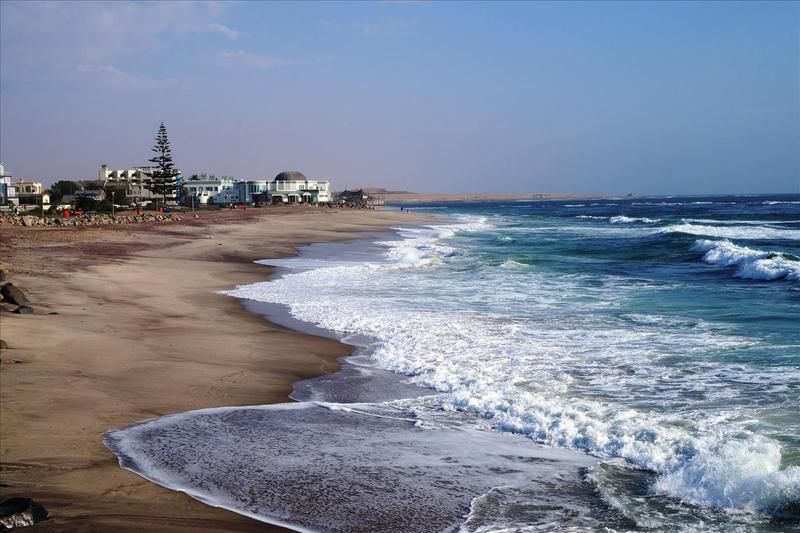 |
|
|
|
Post by onlyMark on Mar 14, 2017 15:43:36 GMT
|
|
|
|
Post by onlyMark on Mar 14, 2017 15:43:56 GMT
|
|
|
|
Post by onlyMark on Mar 14, 2017 15:44:20 GMT
|
|
|
|
Post by onlyMark on Mar 14, 2017 15:44:45 GMT
|
|
|
|
Post by onlyMark on Mar 14, 2017 15:45:17 GMT
|
|
|
|
Post by breeze on Mar 14, 2017 16:31:31 GMT
Unexpected architecture, and I can't say I've seen much like it in our travels. I should get out more.
How do you think those dead trees support the weight of the empty nests, let alone when every finch is at home?
|
|
|
|
Post by bjd on Mar 14, 2017 16:33:48 GMT
It just doesn't look like Africa! Most of those houses could be dropped in Germany and nobody would notice the difference.
|
|
|
|
Post by onlyMark on Mar 14, 2017 17:28:01 GMT
Breeze, that is the trick. You see, the trees can't support the weight so it needs to be about half full all the time with the birds flapping away like crazy to lift the weight off the branches.
Shift change is usually about sunset when the night shift comes on. The other half of the residents then do their bit.
|
|
|
|
Post by onlyMark on Mar 14, 2017 17:30:00 GMT
bjd, it certainly isn't what you picture in your mind when you think of 'real' Africa. That's for sure.
|
|
|
|
Post by breeze on Mar 14, 2017 17:34:30 GMT
Mark, that is such a clear and convincing explanation that I ran right over to wikipedia and pasted it in. You don't mind that I used your name, do you?
|
|
|
|
Post by bixaorellana on Mar 14, 2017 19:34:04 GMT
So interesting, so unexpected! Well, the first part fit my expectations, with all that beautiful expanse of open, unspoiled land. I guess what mostly surprises me is that the German part doesn't seem like a remnant at all, but more of a time-travel geopolitical outpost -- as thought they'd gone to a human-compatible planet & decided to make it all homey.
From all the hotels and the renovation of the jetty, I suppose the town gets quite a few visitors, but it's pretty empty looking in the pictures -- off season? I love The Village Café. Are the overhead flags some kind of local textile craft? They're lovely.
The finch nests are all perfectly thatched! Do they come back to them every year & maintain & add to them? Amazing.
Super interesting thread, Mark. I'd love to see more.
|
|
|
|
Post by onlyMark on Mar 14, 2017 20:03:01 GMT
Breeze, I'd be honoured. I'm sure the entry would stay there until the end of time.
Or maybe not.
But I bet some would be gullible enough to believe it.
|
|
|
|
Post by onlyMark on Mar 14, 2017 20:31:03 GMT
It's a bit of a mystery to me with Swakopmund how the German influence has stayed so strong after such a short period of time as a colony when it was ruled by other for many, many years afterwards. It is a bit of an anomaly.
The flags I think are all traditional patterns, initially tribal, but have developed more into an art form with many variations both modern and old. That is my understanding.
As regards the birds, I have to admit I'm not sure if they come back to the same spot year after year and resume in their old nest or build a new one. I'm not even sure if they actually migrate far anyway at all. I am sure that the year after the breeding season new males will come and add on to a nest, then try and attract a mate by hanging off the bottom entrance and calling. I think they even have a colour change of plummage at that time as well.
I'll have to look into that.
|
|
|
|
Post by Deleted on Mar 14, 2017 21:17:00 GMT
This is definitely one of your finest sets of photos, Mark. I have been fascinated by the German influence in Namibia ever since I saw a documentary about life in Luderitz on the Skeleton Coast at least 30 years ago. It was pointed out at the time thzt the German defeat in the area turned into a complete abandonment of the people, leaving them totally isolated -- so there was no reason for them to stop speaking German, sort of like the French settlers in Québec.
Just a couple of weeks ago I saw another television series about wildlife protection, but it took place in the English speaking areas of Namibia and ended up at Walvis Bay, and there was no mention at all of German speaking populations.
|
|
|
|
Post by onlyMark on Mar 15, 2017 6:16:52 GMT
I don't think there is German particularly spoken in Walvis Bay as I think they were never there. It was always a British or SA colony. In saying that though I've driven past it countless times and never been into the town. Never had any need when Swakopmund is so close and is more interesting. I'll have to remedy that situation soon though, just to see.
|
|
|
|
Post by onlyMark on Mar 15, 2017 6:46:00 GMT
Moving on the next morning, from the 25 degrees of Swakopmund to the little less bearable 38 to 40 degrees of the proper desert. Vegetation became sparser. In the mid distance you can see a line of small trees which follow what is at the moment a dry river bed. I stopped at that spot many times with groups to make a bit of lunch as it was the only shade for many, many kilometres around - 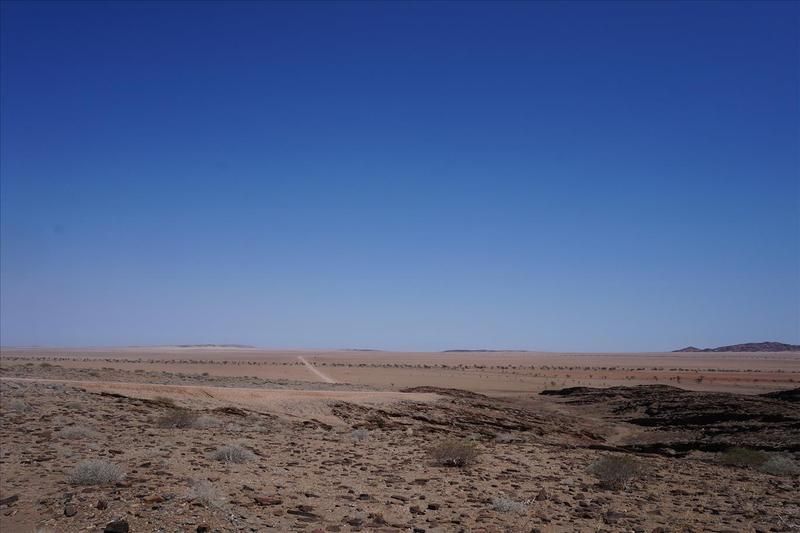 There was a little life elsewhere –  Plus a river but I bet not long before it dies out and soaks into the sand – 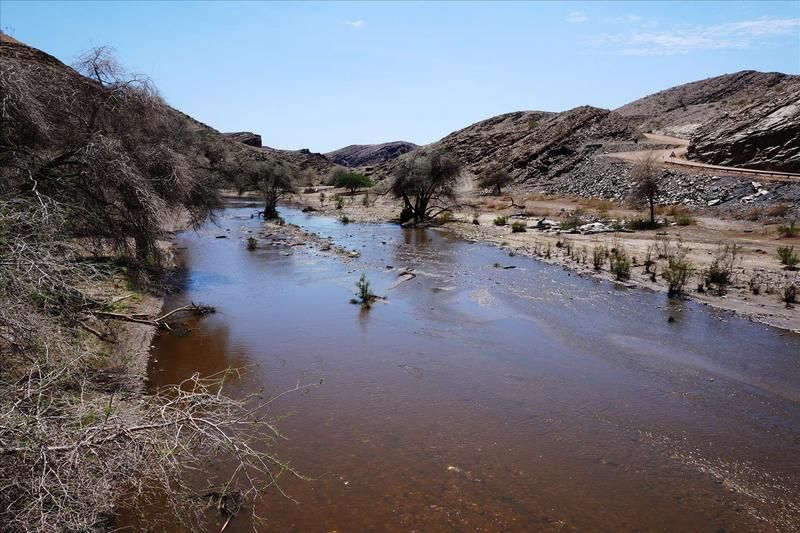  A notable point – 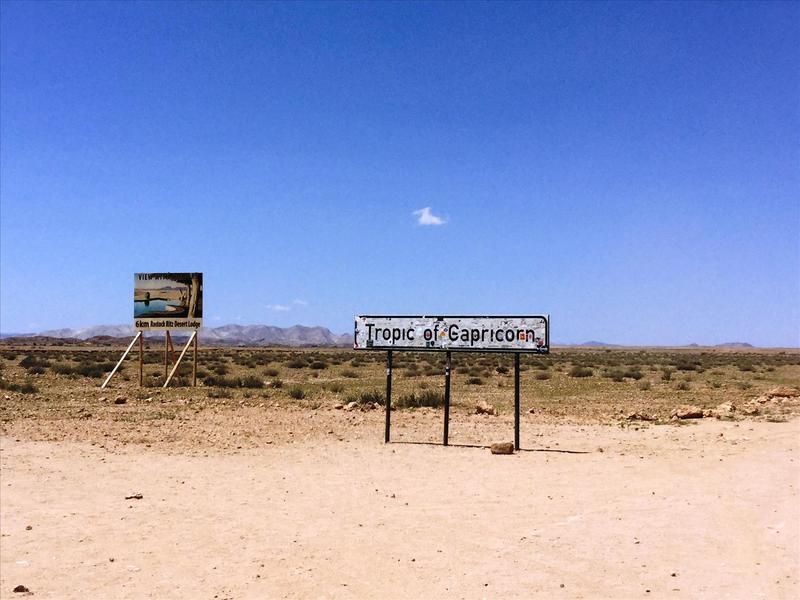 The roads just go on and on. I love it – 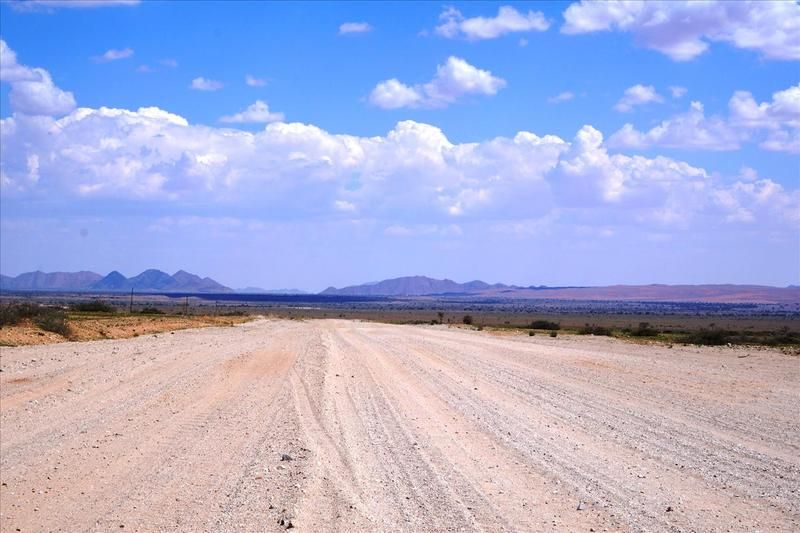 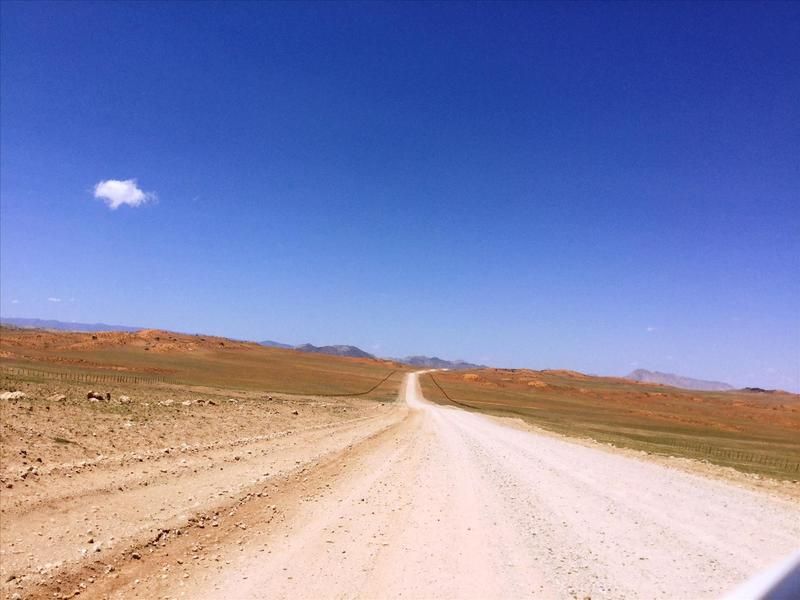 |
|
|
|
Post by onlyMark on Mar 15, 2017 6:48:23 GMT
Out in the middle of nowhere is a place called Solitaire. It isn't a town and no more than a stop off point. But it is famous. Well, famous to those who've been and who know the country. All because of one man. Percy Cross McGregor, known as Moose McGregor. A large area of land was bought from the government in 1948 to raise sheep. The buyer, Willem Christoffel van Coller, built a small dwelling for him and his wife near the junction of two tracks. To overcome the difficulty of water he built a dam on the nearby river to catch all that he could. Realising an opportunity was in the making, he also built a small shop and installed the first petrol pump. A chapel was built to fulfil spiritual needs and a post office opened for more literal needs. His wife, Elsie Sophia, named the area Solitaire. Exactly why is lost in the sands of time (good pun, huh!) but it could be because of the meaning of a single set diamond and/or to mean solitude or loneliness – thus to create the definition of being unique and precious but solitary place. It certainly is and after hours traversing bumpy and dusty gravel tracks it is a welcome sight. Everything ticked along nicely until a little less than twenty five years ago Moose McGregor became the pastry chef at the cafe. Quite why or how and his history eludes me for now but he became the central attraction. Or rather the secret recipe for his Apfel Strudel did. It became legendary and people would drive for miles just to stop there for it and other pastries. Tour buses also began to drop by and queues were out the door. This is what it was like when we arrived -  Difficult to tell the quality but take my word for it, these pastries are excellent – 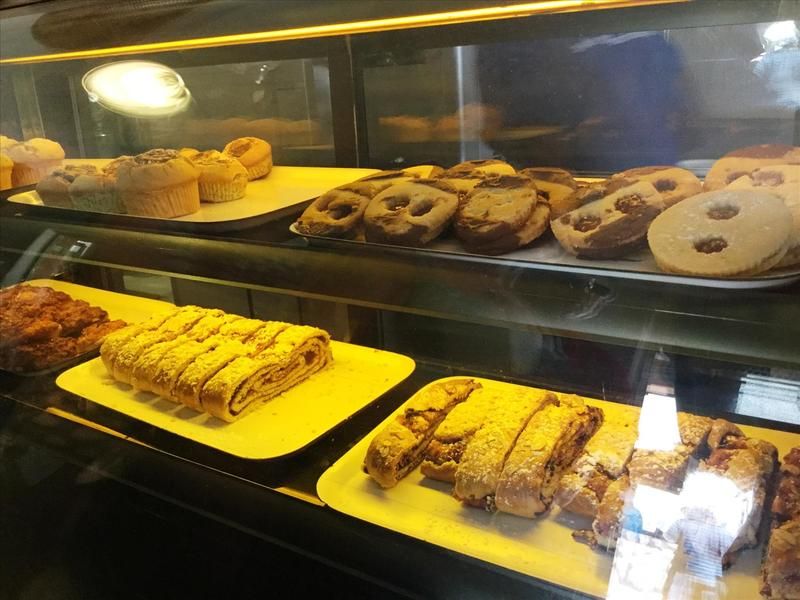 I called there many times and bumped into Moose as he often came round to the 'front of house' for a chat and to get out of the kitchen. But, in 2014 he died. Aged a young fifty six. There are no reports of what but he apparently had breathing difficulties and died whilst his friends were trying to get him into a car to seek help. Obviously there are precious little emergency services available, the nearest ambulance is at Sesreim, 85km away, and at the time was on another call. The nearest hospital is god knows how many hours drive away. His legacy is the staff he trained are still making the apple pie and the other pastries to the same recipes and do still taste as good. They really do. This is the new part of the cafe I'd not seen before, must have been built in the last few years, to cope with all the trade – 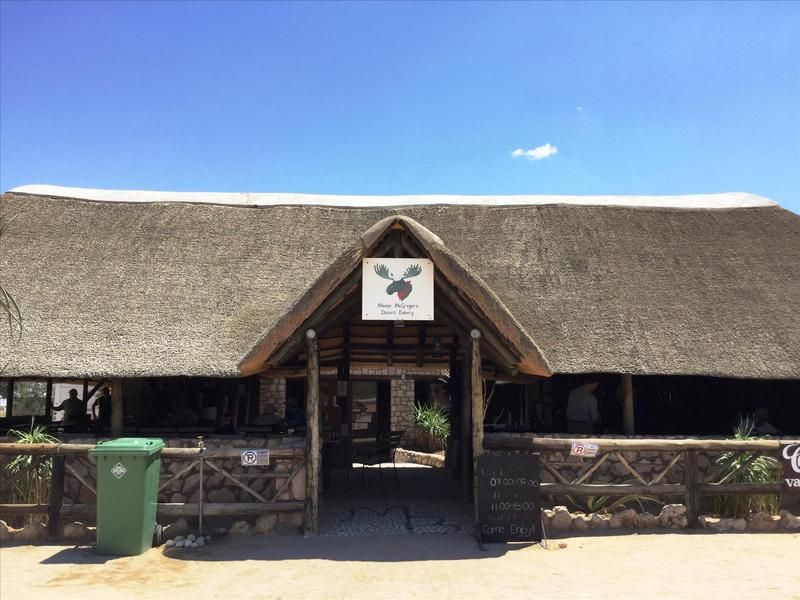 |
|
|
|
Post by onlyMark on Mar 15, 2017 6:49:55 GMT
|
|
|
|
Post by onlyMark on Mar 15, 2017 6:51:10 GMT
A hand written chart, part of the tradition of the place, with the total of the year's rainfall – 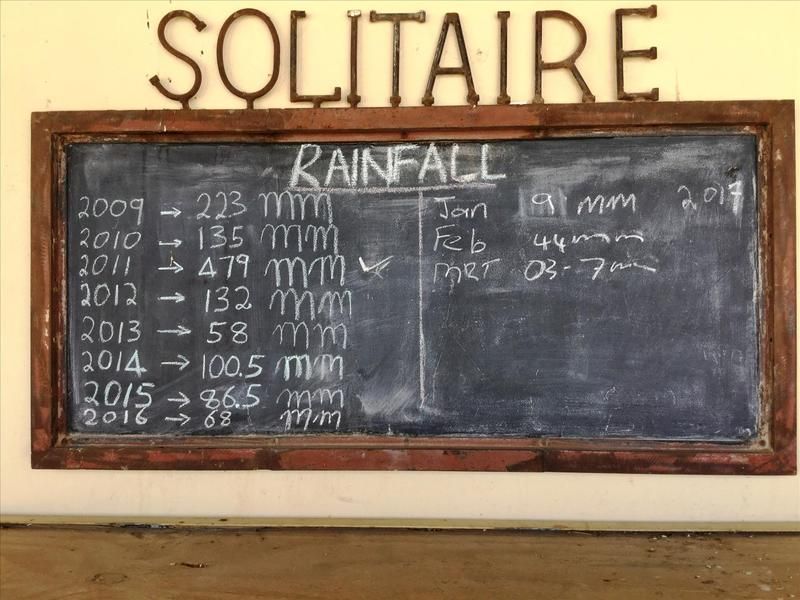 The man himself (not my photo). He stayed single from what I know but always had a word for a pretty lady – 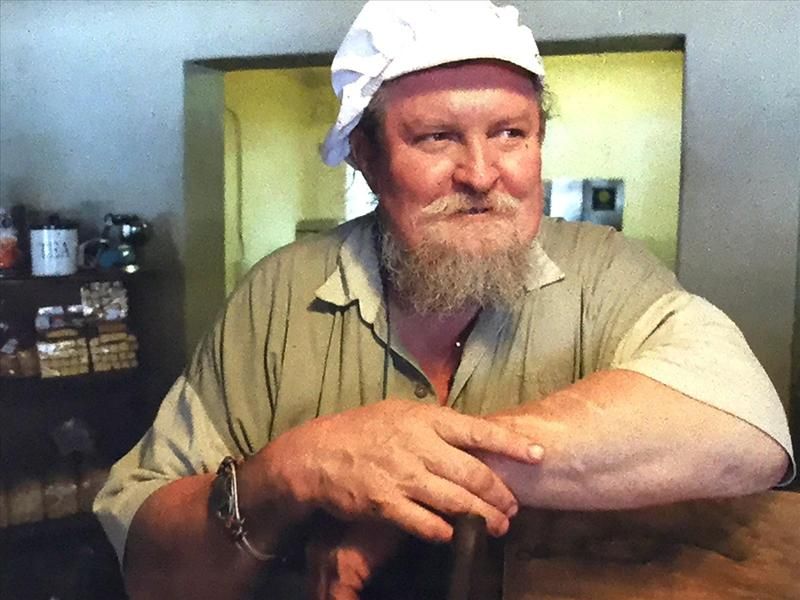 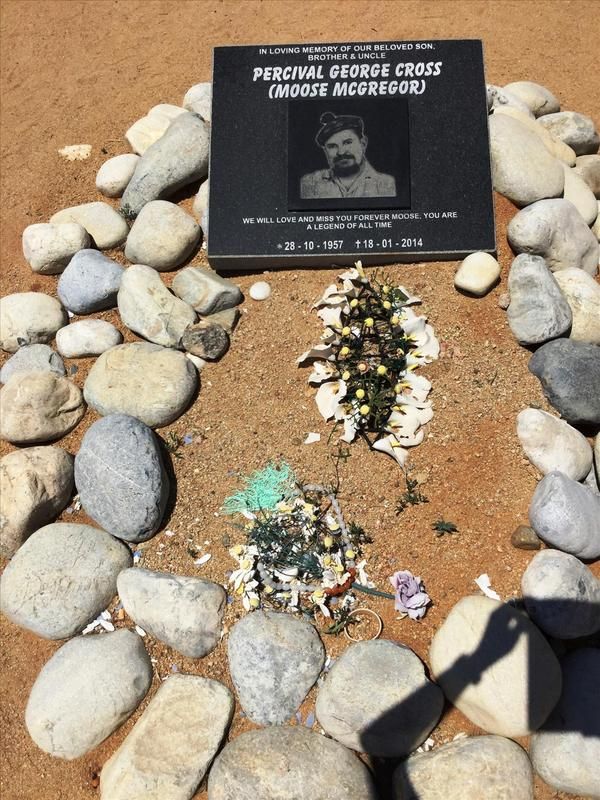 |
|
|
|
Post by onlyMark on Mar 15, 2017 6:53:10 GMT
Just over an hour later, after loosening my belt, we arrived at Sesreim. This is the gateway to the national park that has within it a place called Sossusvlei. No visit to Namibia is complete without going there and it has had as many photos taken of it as Victoria Falls and/or the Queen. However, as it is popular, accommodation nearby can be a bit tricky. For many years the only thing was a government run campsite but over time more and more have jumped on the area and opened up various lodges and camps. You see the problem is, the gate to the national park opens at sunrise, however, the tradition is that at sunrise itself you have to be at the top of a sand dune 45km away in the park. This leads to a Wacky Races scenario and the road only recently having been fully asphalted again. If you've ever driven in Egypt on one of their convoys or in Cairo or a major Asian city, you'll get the picture. Absolute bedlam. I wasn't going to do this again but where to stay was still a problem. I wasn't going to pay the 400 euros a night for a lodge and didn't want to camp, so I plumped for a company called Taleni Africa which ran in the immediate area a lodge (too expensive) a camp for your own car/tent (too basic), a new petrol station and a cafe, but also what suited us was two camps that fitted into the category of "glamping" – Desert Camp and Desert Quiver Camp. Both just 4km from the gate and within 1km of each other. I contacted then about a two night stay but to be told they only had vacancies at one camp one night and the other camp the other night. No problem for us so that's where we went. First to Desert Camp. This is what it was like and was self catering though you could just go to the lodge and have meals there each night, which we did. Views of the camp and surroundings - 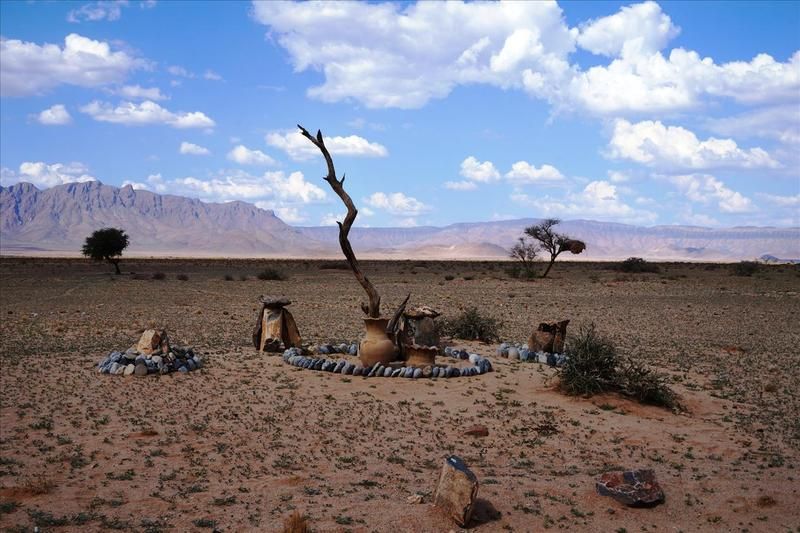 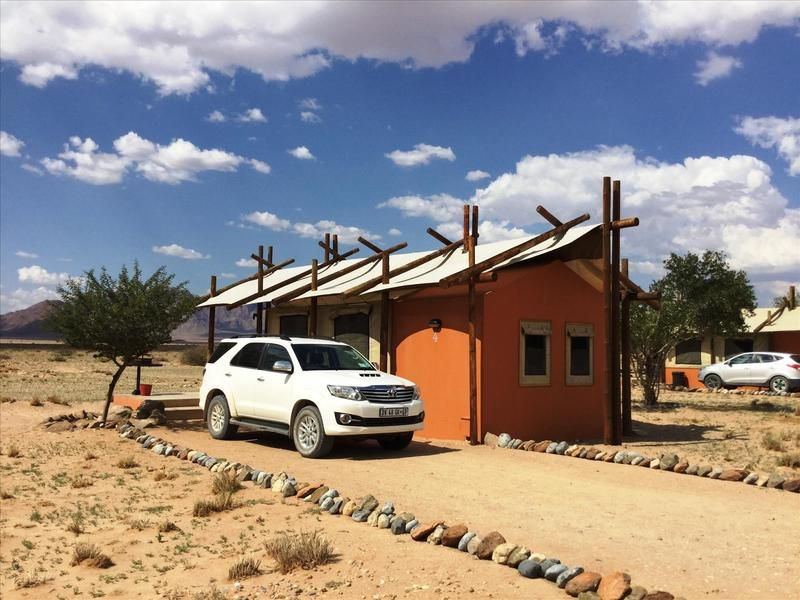 Here you can see the outside kitchen with cooker, fridge and sink –  |
|
|
|
Post by onlyMark on Mar 15, 2017 6:56:04 GMT
|
|
|
|
Post by bjd on Mar 15, 2017 7:08:52 GMT
That looks really interesting, Mark. I admit I prefer greenery to desert landscapes, but I would imagine that driving for long distances over such scenery, you would begin to note small differences in colour, sound and views. I think too that you chose a good time to go, when there is a bit of green stuff coming up occasionally.
The place you stayed looks fine, although the mind boggles at the swimming pool!
|
|
|
|
Post by mossie on Mar 15, 2017 9:23:23 GMT
Sooner you than me Mark, just looks like hell on earth, only one step away from the delights of the Suez Canal Zone of sacred memory.
Re the green, I vividly remember the first spring I was out there we were low flying across the nearby desert when I realised there was a greenish sheen on the ground. Later i found there are plants, the seeds of which can lie dormant for years, which spring into life at the sniff of a heavy dew. They flower, produce seeds, and die all more or less the same day. But leaving those vital seeds to continue the species when suitable conditions occur, maybe years later.
|
|
|
|
Post by Deleted on Mar 15, 2017 9:32:17 GMT
It looks quite a bit like the area around Uluru in Australia, although that is obviously more developed.
|
|